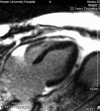Acute pulmonary edema following pericardiocentesis for cardiac tamponade
- PMID: 18060102
- PMCID: PMC2652007
- DOI: 10.1016/s0828-282x(07)70887-5
Acute pulmonary edema following pericardiocentesis for cardiac tamponade
Abstract
Pericardiocentesis for therapeutic drainage of pericardial fluid may be associated with a variety of complications, including laceration of the right ventricle or coronary artery, arrhythmias, viscus perforation, hypotension, pneumothorax, adult respiratory distress syndrome and death. Hemodynamic derangements such as acute left ventricular failure, pulmonary edema and cardiogenic shock are infrequent and, hence, less well recognized. The present report describes a patient with pericardial effusion and tamponade who developed cardiogenic shock requiring inotropic support shortly following uncomplicated ultrasound-guided pericardial drainage.
Une ponction péricardique en vue du drainage thérapeutique du liquide péricardique peut s’associer à diverses complications, y compris une lacération du ventricule droit ou de l’artère coronaire, des arythmies, une perforation des viscères, une hypotension, un pneumothorax, un syndrome de détresse respiratoire aiguë et un décès. Les perturbations hémodynamiques, telles qu’une insuffisance ventriculaire gauche aiguë, un œdème pulmonaire et un choc cardiogène sont rares, donc moins bien dépistées. Le présent rapport décrit le cas d’un patient souffrant d’effusion péricardique et de tamponnage, qui a développé un choc cardiogène exigeant un soutien inotrope peu après un drainage péricardique orienté par échographie sans complication.
Figures


References
-
- Vandyke WH, Jr, Cure J, Chakko CS, Gheorghiade M. Pulmonary edema after pericardiocentesis for cardiac tamponade. N Engl J Med. 1983;309:595–6. - PubMed
-
- Spodick DH. The normal and diseased pericardium: Current concepts of pericardial physiology, diagnosis and treatment. J Am Coll Cardiol. 1983;1:240–51. - PubMed
-
- Glasser F, Fein AM, Feinsilver SH, Cotton E, Niederman MS. Non-cardiogenic pulmonary edema after pericardial drainage for cardiac tamponade. Chest. 1988;94:869–70. - PubMed
-
- Wolfe MW, Edelman ER. Transient systolic dysfunction after relief of cardiac tamponade. Ann Intern Med. 1993;119:42–4. - PubMed
Publication types
MeSH terms
LinkOut - more resources
Full Text Sources
Medical

